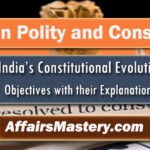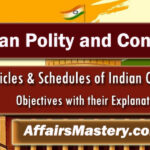Set 6 | Important Indian Constitution Evolution MCQs
Important Indian Constitution Evolution MCQs. The way the Indian Constitution has evolved over time plays a huge role in shaping Indian Polity and Governance, and it’s one of those things that really lays the groundwork for doing well in competitive exams—whether it’s Civil Services, State exams, SSC, Railways, Banking, or any of the others out there. Diving deep into Indian Polity, Constitution, and governance isn’t just about memorizing facts or ticking boxes for exams, but more about developing the kind of awareness that can make navigating these challenging exams a little less overwhelming and a lot more manageable.
| MCQs on Indian Constitution Evolution – Objective Questions and Answers |

Q51. Who was the Constitutional Advisor at the time of the formation of the Constitution? (U.P.P.C.S. (Pre) 2014)
[A] Dr. B.R. Ambedkar
[B] Dr. Rajendra Prasad
[C] B.N. Rau
[D] K.M. Munshi
View Explanation
Correct Answer is C.
B.N. Rau was the one who worked as the Constitutional Advisor when India was in the process of forming its Constitution. His role was important because he was the one who first put together a draft of the Constitution. This draft later went through a lot of discussions and modifications by the Drafting Committee, which was headed by Dr. B.R. Ambedkar. Rau’s work laid the foundation, making it easier for the committee to refine things and finalize the document.
- Dr. B.R. Ambedkar – He was the Chairman of the Drafting Committee, which means he had the major responsibility of shaping the final version of the Constitution. His contributions were huge, especially in structuring things like fundamental rights and social justice aspects.
- Dr. Rajendra Prasad – He was the President of the Constituent Assembly, meaning he was the one overseeing the entire process of Constitution-making. Later on, he also became India’s first President.
- K.M. Munshi – He was a member of the Drafting Committee too, and he had a strong influence on several parts of the Constitution. He was involved in shaping important sections, including the ones related to fundamental rights.
Each of these people had a crucial role in giving India its Constitution, but when it comes to the Constitutional Advisor specifically, that was B.N. Rau.
Q52. The first draft of the Constitution was prepared by- (U.P. Lower (Pre) 2009)
[A] B.R. Ambedkar
[B] B.N. Rau
[C] K. Santhanam
[D] K.M. Munshi
View Explanation
Correct Answer is B.
B.N. Rau was the one who initially prepared the first draft of the Indian Constitution. His work provided a base for the Drafting Committee, which was later responsible for reviewing and making changes to it. This committee was chaired by Dr. B.R. Ambedkar, who played a key role in finalizing the Constitution.
- B.R. Ambedkar – He was the Chairman of the Drafting Committee and had the major responsibility for shaping the final version of the Constitution, ensuring key provisions like fundamental rights were included.
- K. Santhanam – He was a constitutional expert and journalist but wasn’t directly responsible for drafting the Constitution. He later contributed to administrative reforms in India.
- K.M. Munshi – He was a member of the Drafting Committee and actively contributed to sections related to fundamental rights and governance.
Even though Ambedkar is often credited with the final draft, it was B.N. Rau who originally prepared the first draft, which was then refined by the committee.
Q53. When did the Constituent Assembly adopt the National Flag?
[A] 22 July, 1947
[B] 23 July, 1947
[C] 25 July, 1947
[D] 15 August, 1947
View Explanation
Correct Answer is A.
On 22nd July 1947, the Constituent Assembly of India officially adopted the National Flag of India. This was just a few weeks before India gained independence on 15th August 1947. The flag they adopted was very similar to what we see today—a tricolor of saffron, white, and green with the Ashoka Chakra in the center, replacing the spinning wheel (Charkha) from the earlier version used by the Indian National Congress.
- 23 July 1947 – No significant event related to the flag happened on this day.
- 25 July 1947 – Again, nothing related to the adoption of the national flag took place on this date.
- 15 August 1947 – This was the day India gained independence, but the flag was already officially adopted by then. However, it was on this day that it was hoisted for the first time as the national flag of independent India.
Q54. Who was the chairman of the National Flag Committee? (U.P.P.C.S. (Pre) 1991)
[A] C. Rajagopalachari
[B] Dr. Rajendra Prasad
[C] J.B. Kripalani
[D] Dr. B.R. Ambedkar
View Explanation
Correct Answer is B.
Dr. Rajendra Prasad, who was the President of the Constituent Assembly, also served as the Chairman of the National Flag Committee. This committee was responsible for finalizing the design of the Indian National Flag, which was officially adopted on 22nd July 1947.
- C. Rajagopalachari – He was India’s last Governor-General, but he had no direct role in the flag committee.
- J.B. Kripalani – He was a senior Congress leader and had a role in the freedom movement, but he did not chair the flag committee.
- Dr. B.R. Ambedkar – He was the Chairman of the Drafting Committee for the Indian Constitution but wasn’t involved in the flag committee.
Q55. Consider the following statements: (U.P.P.C.S. (Mains) 2004)
1. The design of the National Flag was adopted by the Constituent Assembly of India on 22nd July, 1947
2. The wheel in National Flag has 21 spokes
3. The ratio of the width of the National Flag to its length is 3 : 4
Which of the above statements is/are correct ?
[A] 1 and 2
[B] 1 only
[C] 2 and 3
[D] 2 only
View Explanation
Correct Answer is B.
- The design of the National Flag was adopted by the Constituent Assembly of India on 22nd July 1947 – True
- The Constituent Assembly officially adopted the tricolor flag with the Ashoka Chakra on 22nd July 1947, before India gained independence.
- The wheel in the National Flag has 21 spokes – False
- The Ashoka Chakra in the center of the flag actually has 24 spokes, not 21.
- The ratio of the width of the National Flag to its length is 3:4 – False
- The correct ratio of width to length of the Indian National Flag is 2:3, not 3:4.
Q56. The Constitution of India was completed on: (U.P.P.C.S. (Mains) 2010)
[A] January 26, 1950
[B] November 26, 1949
[C] February 11, 1948
[D] None of the above is correct
View Explanation
Correct Answer is B.
- The Preamble of the Indian Constitution starts with the words “We the People of India” and mentions that on 26th November 1949, the people of India enacted, adopted, and gave themselves this Constitution. This particular date is really important because it marks the day when the Constitution was completed, adopted, and officially passed.
- But not everything in the Constitution became active immediately. On the same day, a few important provisions, like those related to Citizenship, the Interim Parliament, and Emergency powers, were put into effect.
- It was only on 26th January 1950 that the entire Constitution came into force, which is why that date is now celebrated as Republic Day—the day India truly started functioning under its new constitutional framework.
Q57. Mention the correct date of the last meeting of the Constituent Assembly of India? (U.P.P.C.S. (Pre) 2018)
A] 26 Nov. 1949
[B] 5 Dec. 1949
[C] 24 Jan. 1950
[D] 25 Jan. 1950
View Explanation
Correct Answer is C.
- The last meeting of the Constituent Assembly of India was held on 24th January 1950. On this day, all the members signed the final draft of the Constitution, officially giving it the final seal of approval.
- Additionally, Dr. Rajendra Prasad was elected as the first President of India during this meeting.
Q58. January 26 was selected as the date for the inauguration of the Constitution, because- (53rd to 55th B.P.S.C. (Pre) 2011)
[A] The Congress had observed it as the Independence Day in 1930.
[B] On that day the Quit India Movement was started in 1942.
[C] It was considered to be an auspicious day.
[D] None of the above.
View Explanation
Correct Answer is A.
- 26th January was chosen as the date to enforce the Indian Constitution because, on this very day in 1930, the Indian National Congress (INC) had declared “Purna Swaraj” (Complete Independence) from British rule in Lahore Session under the leadership of Jawaharlal Nehru.
- Since 26th January already had historical significance in India’s freedom struggle, it was selected as the day when the Constitution would come into effect, marking the birth of the Republic of India in 1950.
Q59. Indian Constitution was adopted by – (39th B.P.S.C. (Pre) 1994)
[A] Constituent Assembly
[B] British Parliament
[C] Governor-General
[D] Indian Parliament
View Explanation
Correct Answer is A.
- The Indian Constitution was adopted on 26th November 1949 by the Constituent Assembly of India. This assembly was formed in 1946 and was responsible for drafting, debating, and finalizing the Constitution.
- Dr. Rajendra Prasad was the President of the Constituent Assembly, and Dr. B.R. Ambedkar was the Chairman of the Drafting Committee.
Q60. The Constitution of India was enacted on 26 November, 1949 by the – (U.P. P.C.S. (Mains) 2012)
[A] Constituent Assembly
[B] Governor General of India
[C] Parliament of India
[D] British Parliament
View Explanation
Correct Answer is A.
- The Constitution of India was adopted by the Constituent Assembly on 26th November 1949. However, it came into full effect on 26th January 1950, which is why 26th January is celebrated as Republic Day.
- The Constituent Assembly, formed in 1946, was responsible for drafting, debating, and finalizing the Constitution. Dr. Rajendra Prasad was the President of the Constituent Assembly, and Dr. B.R. Ambedkar was the Chairman of the Drafting Committee.
Related articles:
- Set 1 | Important Indian Constitution Evolution
- Set 2 | Important Indian Constitution Evolution
- Set 3 | Important Indian Constitution Evolution
- Set 4 | Important Indian Constitution Evolution
- Set 5 | Important Indian Constitution Evolution
- Set 7 | Important Indian Constitution Evolution
- Set 8 | Important Indian Constitution Evolution




